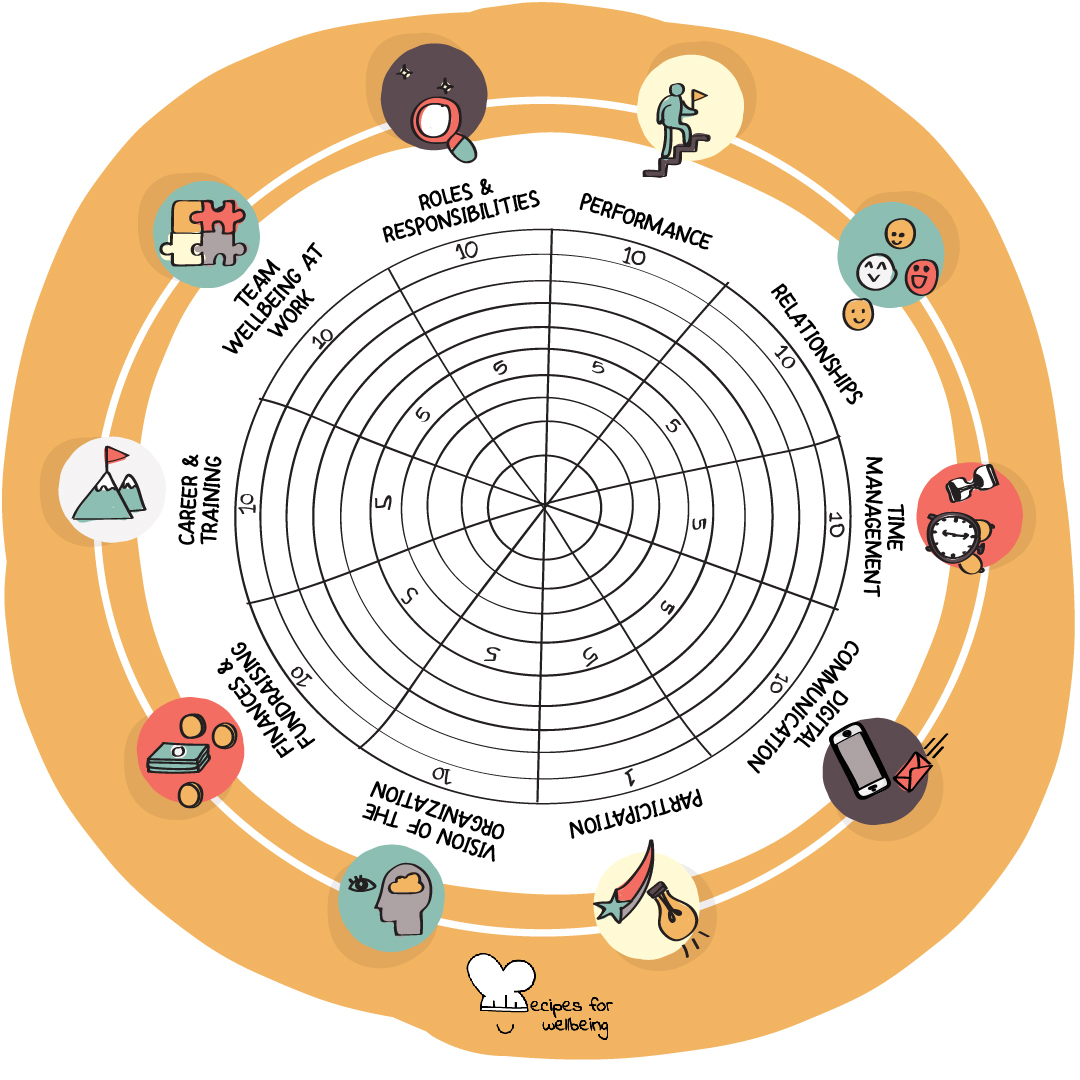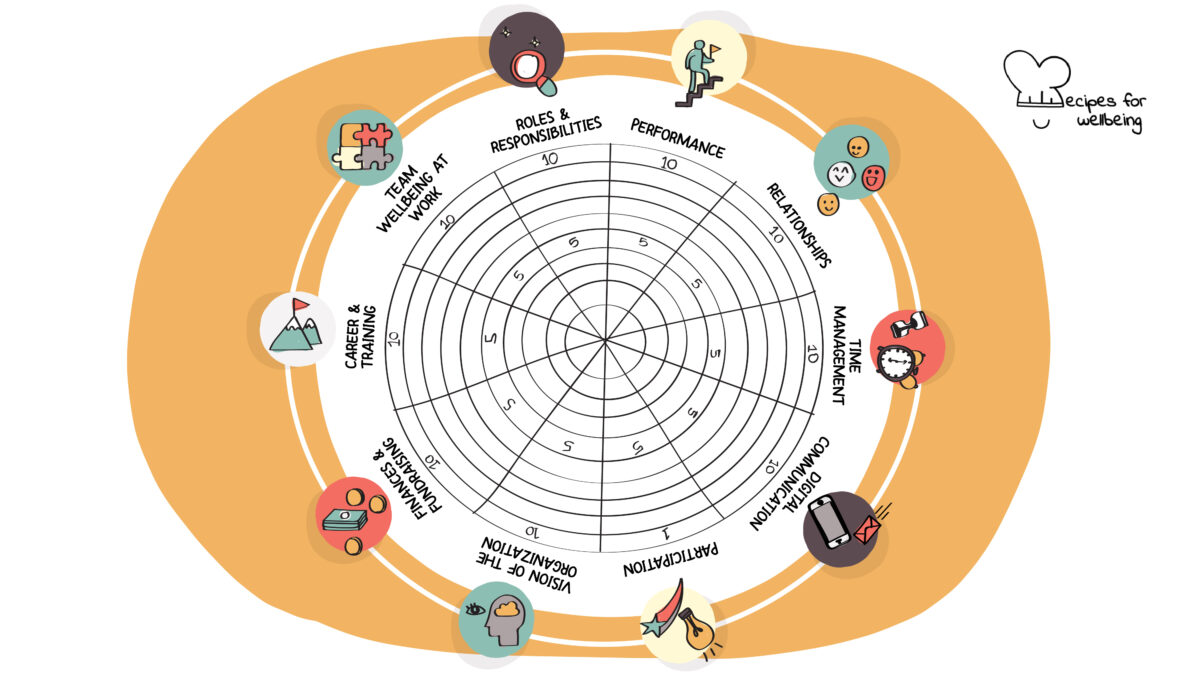
The wheel of wellbeing at work
Wholeness does not mean perfection: it means embracing brokenness as an integral part of life. Knowing this gives me hope that human wholeness—mine, yours, ours—need not be a utopian dream, if we can use devastation as a seedbed for new life. ―Parker Palmer
👥 Serves: 1–50 people
🎚 Difficulty: Medium
⏳ Total time: 30’–90’
🥣 Ingredients: Wheel of wellbeing at work template, a pen or marker
💪 Nutritional values: Awareness, Perspective, Appreciation, Focus, Clarity

The wheel of wellbeing at work
📝 Description
Take a snapshot to assess wellbeing at work.
Wellbeing also exists at the intersection of personal and organisational life. This recipe is an adaptation of the wheel of wellbeing to help you and your team map your levels of wellbeing and bad-being in the workplace. You will be guided through a series of reflective prompts to help you assess your current level of wellbeing and bad-being in different areas of work so you can get a better understanding of where you are thriving and where you are languishing. Importantly, this is NOT a picture of how the situation was in the past or how it will be in the future.
There are three ways to approach this practice:
- Individual: You can do it by yourself whenever you want to evaluate your overall level of wellbeing at work.
- Peers: You can do it with someone else in your team or organisation where the first part is an individual assessment and the second part a peer-coaching process where you take turns in being the coach and the coachee.
- Collective: You can do it with everyone in your team or organisation where the first part is an individual assessment and the second part a collective sense-making process to highlight patterns across the team or organisation.
We shall provide brief instructions for each of the three pathways.
👣 Steps
Step 1 – Preparation (5’)
Download and print the “wheel of wellbeing at work” template (alternatively, you can simply download it and edit it digitally or even draw your own).
Step 2 – Guidelines (5’)
You are invited to reflect on each of the ten areas represented in the wheel of wellbeing at work and rate your level of wellbeing and bad-being over the past three months (prompts in the following step to guide you). You can rate each area by placing a dot on a scale from 1 (closest to the centre of the wheel) to 10 (furthest from the centre of the wheel), where 1 means you are experiencing high levels of bad-being in this area (e.g. you are languishing, you are extremely dissatisfied) and 10 means you are experiencing high levels of wellbeing in this area (e.g. you are thriving, you are extremely satisfied). Bear in mind that this is not a perfect science, so don’t overthink and follow your heart when you are stuck. Also, bear in mind that your wheel is completely subjective: your “8” might be equivalent to someone else’s “4”. It is not a competition.
Step 3 – Assessment (10’)
Let’s start! Read through the prompts to guide your reflection. We advise you to consider a timeframe of 3 months, but feel free to adapt to a timeframe that works best for you.
- Roles and responsibilities • Are you satisfied with your role and your responsibilities within the team/organisation? Do you feel stimulated and appreciated for your skills?
- Performance • Are you satisfied with your performance? Could you give more? Or are you overwhelmed and struggling to keep up?
- Relationships • Are you satisfied with your relationships with the rest of the team, partners, clients, etc.? Can you count on others in the team if you need help? How is the atmosphere in the team?
- Time management • We all have 24 hours, but some people can manage their time better. Are you satisfied with your time management? Can you complete projects on time or are you always in a rush?
- Digital communication • Are you satisfied with the way you manage your communication, e.g. email, instant messages, etc.? How much time do you spend on your digital communication?
- Participation • Are you satisfied with your participation, in the team, in the organisation, in the projects? Can you have your say and share ideas?
- Vision of the organisation • Are you satisfied with the vision and direction of your team/organisation? Are they aligned with your professional vision and direction?
- Finances and fundraising • Are you satisfied with your income to meet your needs? Do you have the financial security and independence you want? Do you manage to secure the funds you need?
- Career and training • Are you satisfied with where you are now professionally? Is your career going in the direction you want? Do you make room for training and growth in your role?
- Team wellbeing at work • Are you satisfied with the level of wellbeing within your team and organisation overall?
Step 4 – Connect the dots (5’)
Now take a moment to connect the dots between the different “spikes” of the wheel so you form an inner wheel. When you are done, look at your inner wheel and consider: If this wheel was an actual tire on your car, how bumpy would the ride be?
Step 5 – Sensemaking (if alone) (5’)
If you are doing this alone, use the next five minutes to consider:
- In which areas are you doing surprisingly well, experiencing high levels of wellbeing?
- In which areas did you score uncomfortably low, experiencing high levels of bad-being?
- Which areas are particularly interconnected, so if one goes up, the other one goes up as well (or down)?
Step 6 – Peer-coaching (if in pairs) (60’)
If you are doing this with a fellow team member, use the next hour to peer-coach each other and help you identify areas where you want to see some changes in the next 6 months to a year. Take it in turns to be the coach and coachee. If you are unsure how to approach a peer-coaching process, check out our recipe “A way into your purpose” and read the description with a few guidelines on how to be successful in your role.
Step 7 – Group reflections (if in a group) (60’)
If you are doing this with your entire team or organisation, use the next hour to unpack what has emerged. Consider:
- What patterns do you notice?
- Where is your team doing well?
- Where is your team struggling the most?
- What tensions are emerging between your organisational values and how people really feel?
Make sure to nominate one person (or more people) to collect insights from this sensemaking process so you can then implement changes to improve wellbeing at work.

